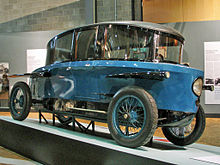Car glass
As auto glass is called glass that for, windscreen , - rear and side windows of automobiles is used.
history
The first automobiles were still openly built. The driver and passengers sat unprotected in the vehicles. Later, only a windshield was installed on the front of the car to protect the driver and passengers from the airflow and the precipitation , insects and dirt particles that fly with it . Simple flat glass was used , which could cause serious injury if broken. With the transition to the closed cabins (initially only for passengers), the manufacturers then also installed the side windows.

The Rumpler drop car (1921–1925) was the first automobile to feature curved glass panes.
Manufacturing
Until 1900, clear, fire-polished window glass was produced exclusively using the mouth-blowing process. In 1905 the Belgian Fourcault succeeded for the first time in pulling a sheet of glass directly from the molten glass. In 1917 the American Colburn developed another drawing process with the support of the Libbey Owens Society. In 1928 the Pittsburgh-Plate-Glass-Company combined the advantages of the Fourcault process with those of the Libbey-Owens process .
This was followed by the development of continuous grinding processes for large-area glass panels.
At the end of the 50s, it was the idea of the Englishman Pilkington that made glass production possible under economical conditions. The liquid glass ribbon is directed over an ideally flat surface, namely a metal bath. The glass floats as an endless band on a gas film between the metal bath and the glass surface; During the solidification phase, it is guided through a long cooling channel on a roller belt.
The majority of the panes that are installed in vehicles are curved. Either the gravity bending process or the press bending process are used as the bending process.
Performance of a modern float glass plant : up to 3000 m 2 / h and up to 800 t per day.
Designs
- One-piece straight discs
- Straight discs divided in the middle
- Curved discs
Mounting forms
Until the early 1990s, the front and rear windows were retracted with rubbers. After that, due to the stability of the vehicle and the introduction of airbags, the gluing of the glass prevailed. Nowadays, windshields are supporting body parts which have a significant share in the body rigidity.
Safety glass
Single pane safety glass (ESG)
As the first real safety glass, hardened and toughened panes came onto the market in the manufacture of single-pane safety glass. If they break, these disintegrate into numerous small pieces. The edges of the glass splinters are still sharp, but the fragments are so small that they can no longer cause deep injuries. Today they are mainly used for side and rear windows.
Laminated safety glass (VSG)
Later appeared then laminated safety glass , the two glass layers are bonded by a film. The laminated safety glass is mainly used for windscreens. In the film of the laminated safety glass, functions such as B. heating or antenna systems can be integrated.
equipment
- Color: white, blue, bronze or green, with blue, green or gray sun protection strips.
- Provided with a tint film : reduces UV radiation in the interior of the car, reduces the amount of heat radiation .
- Alternatively, there is also heat protection glass : Here, a firmly adhering film is applied to the inside of the first pane with a metallic substance. This property allows the thermal radiation to be reflected .
- Heatable.
- Equipped with antenna for the car radio.
- Equipped with sensors : react to rain , light and humidity .
- Self-cleaning or water-repellent.
- Head-up display (HUD): Projects driving information such as speed , navigation instructions and control displays onto the windscreen.
- Equipped with brackets for driver assistance systems ( lidar , front camera ); for recognizing traffic signs, dangerous situations ( emergency braking ) and keeping the lane while driving ( lane assist )
Functions
Nowadays, the windshield is not only a useful addition to the car, it has also become an important design element. Another important role of the bonded windshield is that the windshield contributes to the rigidity of the body. The airbag on the passenger side is based on opening from the inside against the windshield from, so it must also bear the burden thus created.
Falling rocks
Stone chips in the laminated glass can often also be repaired. In many modern car glass workshops, the repair, which usually takes about 30 minutes, is carried out with a highly transparent synthetic resin, which fills the damaged area and is then cured with UV light. The strength of the disk is almost restored and the disk does not have to be replaced at great expense.
The technical requirements for this are: size in diameter including cracks no more than 3 cm, size of the damaged surface no more than 5 mm, neither dirt nor moisture must have got into the damaged area, and the cracks must not end at the edge of the pane. Another requirement according to StVZO: Stone chips in the “driver's far field of vision” may not be repaired, as the optics cannot be 100% restored. The legislator describes the “driver's far field of vision” for cars and other vehicles up to 3.5 t GVW as follows: 29 cm wide in the center above the steering wheel, up and down as far as the wiper blade extends.
literature
- Peter Gerigk, Detlev Bruhn, Dietmar Danner: Automotive engineering. 3rd edition, Westermann Schulbuchverlag GmbH, Braunschweig 2000, ISBN 3-14-221500-X
- Karl-Heinz Dietsche, Thomas Jäger, Robert Bosch GmbH: Automotive pocket book. 25th edition, Friedr. Vieweg & Sohn Verlag, Wiesbaden 2003, ISBN 3-528-23876-3
